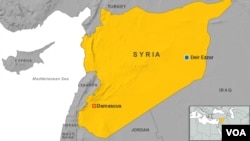A U.S. military general blamed human error for the deadly coalition airstrike in September that killed Syrian government-aligned forces near Deir Ezzor.
Investigating officer Brigadier General Richard Coe said the coalition forces in the strike, which included the U.S., Britain, Australia and Denmark, thought they were striking Islamic State forces.
"We made an unintentional, regrettable error primarily based on human factors," he said.
Coe said the strike killed at least 15 people, but the investigation was unable to determine an exact number because they were unable to visit the bombing site. Russia claimed the strike killed 62 Syrian troops.
Pentagon press secretary Peter Cook told reporters Tuesday that the U.S.-led coalition had not met its high standards during this strike, but he stopped short of apologizing to the Syrian government.
"The investigation determined that although the strikes likely hit forces aligned with the government of Syria, the strikes were conducted under a good-faith belief that the strikes were targeting ISIL in accordance with the law of armed conflict," Cook said, using an acronym for Islamic State.
Reasons for error
According to the U.S. investigation, several factors contributed to the misidentification and subsequent strike.
The forces on the ground were not wearing uniforms, flags or insignias, and they acted like IS fighters, Coe said.
The coalition had initially misidentified a vehicle as containing IS forces, and when that vehicle met up with the friendly camp of Syrian-aligned fighters, the entire group was misidentified.
One intelligence analyst expressed doubt the forces on the ground were IS fighters when he saw a Syrian tank in the camp, Coe said, but that skepticism was ruled out because of the fact that IS had commandeered a Syrian military tank just days prior to the strike.
Finally, the United States had used a safety hotline, which was set up to avoid midair collisions, to inform the Russians that the coalition would be striking near Deir Ezzor, but the informer had incorrectly given the Russians a strike location that was off by three kilometers.
27-minute gap
Once the strike began, a critical communication failure caused more casualties.
When the Russians called the United States back on the hotline to inform the coalition that it was striking Syrian-aligned forces, Coe said the usual point of contact was unavailable.
He said the colonel who answered the phone asked whether the Russians would like to pass on the information, but the Russians declined and hung up. When the Russians called back, he said, they asked to hold until their point of contact was on the line.
The United States then took 27 minutes to get the point of contact to the Russian hotline. Fifteen of the 22 strikes on Deir Ezzor camp happened during that time.
Colonel John Thomas, a spokesman for U.S. Central Command, said the Russians have been asked to immediately convey lifesaving information on the hotline, regardless of who is on the line.









